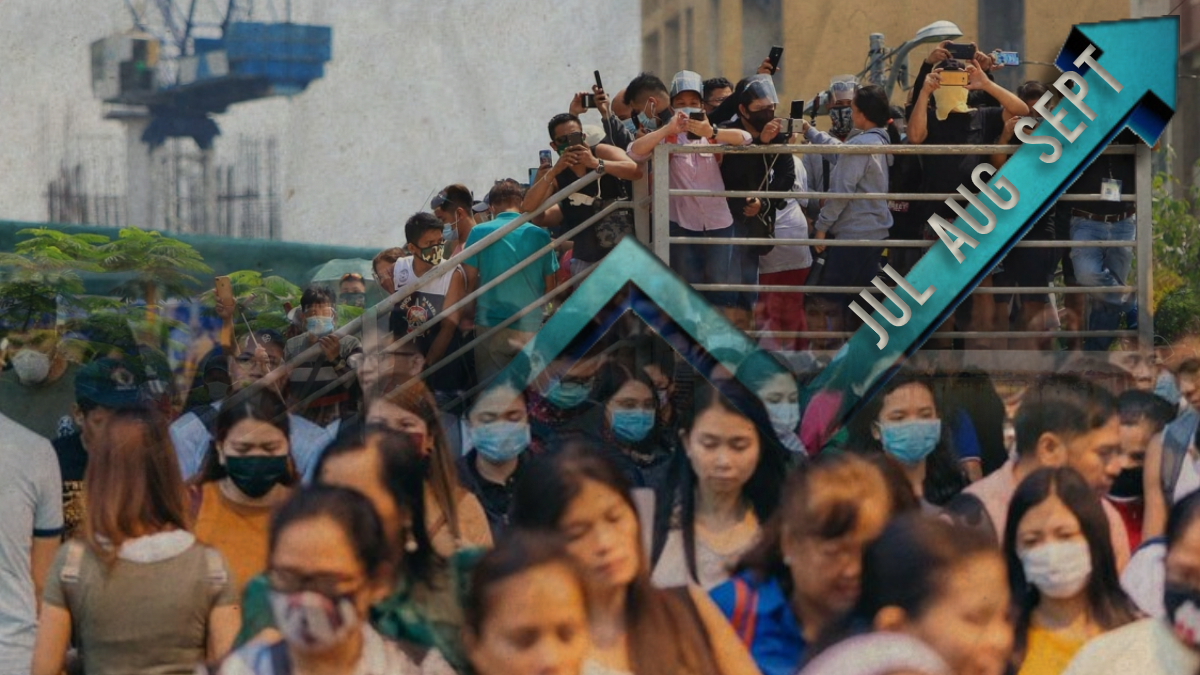
Pyramid Schemes and You
September 21, 2020
Voter registration recommences on Sep 1
September 24, 2020STATE OF INFECTION: The Saga Unfortunately Continues

More than half of the year has passed since the beginning of the Coronavirus outbreak. Different parts of the world have gone to severe means of containing it — from banning inbound flights to strict lockdowns, thus separating us from the life that we grew accustomed to living. This pandemic is no different than a war waged within and between countries. Many lives were lost, many lives continue to be lost, and many lives felt lost. COVID-19 has taken an enormous chunk not only of the citizens’ lives but also their way of living. Businesses have shut down, communities turned against those infected with the virus, and everyone is possibly worried about what may happen to them if the state of our country worsens. It has been approximately seven months since the entry of the virus in the Philippines and the one question that lingers in each person’s mind is, “Are there any improvements?” In an attempt to answer this, here’s a rundown of everything that’s happened in the past couple of months:
THE BUTTERFLY EFFECT
July 3
Presidential spokesperson Harry Roque announced that the Philippines is ready to dispose of some of its assets to fund the purchase of coronavirus vaccines once they become available in the market. He issued the statement as the first out of four Covid-19 vaccines being tested by US pharmaceutical giant Pfizer and its German partner BioNTech reportedly showed “encouraging” results.
July 5
The Philippines recorded its highest single-day increase in COVID-19 cases, reporting 2,434 new infections.
July 13
Confirmed Coronavirus cases in the country reached 57,000. Department of Health (DOH) Undersecretary Maria Vergeire explained that an increased number of deaths and recoveries is to be expected. She further stated that the increase is at a pace where the country’s healthcare system is still able to deal with additional cases.
At least 11 hospitals in Metro Manila have stated that they are at full capacity of beds designated for COVID-19 patients.
TRIAL AND ERROR
July 15
Health Secretary Francisco Duque III stated that the Philippines was already successful in flattening the curve amidst the number of COVID-19 cases still rising, only for him to retract his statement.
July 18
The Department of Science and Technology (DOST) has approved the clinical trials for lagundi against COVID-19. The project aims to determine if the herb can provide symptomatic relief for patients and if it can decrease the number of patients who progress from mild to moderate or severe cases.
July 21
The Philippines’ Ambassador to the United States Jose Manuel Romualdez revealed that the government has reached out to pharmaceutical companies in the US that are developing COVID-19 vaccines. Romualdez assured that once vaccines are available for export, the Philippines will receive such.
July 29
Roque said in an interview that Metro Manila would be a “living experiment,” as he announced that the government would have an “invigorated” pandemic response starting on August 1.
The Bureau of Treasury reported that the country’s debt soared past the P9-trillion mark in June as the government borrows more for pandemic response.
EYE FOR AN EYE
July 31
Metro Manila exceeds 2,000 cases in a single day.
The country hit a new record-high increase as the DOH confirmed 4,063 more cases. Total COVID-19 cases are at 93,354.
August 2
The Philippines has hit 100,000 cases.
80 medical associations signed an open letter asking for a “timeout” and urged President Duterte to revert Metro Manila back to Enhanced Community Quarantine (ECQ) until August 15 to give the country time to “refine our pandemic control strategies”.
“Healthcare workers are united in sounding off a distress signal to the nation—our healthcare system has been overwhelmed,” said the letter addressed to Duterte, Duque, and COVID-19 chief implementor Carlito Galvez Jr.
August 4
A meeting was held between officials from the Duterte administration and representatives of more than 100 medical societies to strategize in raising the hopes of the country’s “losing” battle with the pandemic.
Dr. Antonio Dans of the Philippine College of Physicians and the Philippine Society of General Internal Medicine stated in the meeting, “Pag hindi ho maayos ‘yung strategies sa iba-ibang lugar, ‘pag hindi ho maayos ‘yung strategies sa iba-ibang department, sa ospital din po ang bagsak kasi lalaganap po lalo ang COVID-19.”
He further elaborated the importance of workplace and transportation safety in restraining the spread of the virus.
ALERT: CODE BLACK
August 5
DOH Undersecretary Maria Vergeire discussed in a virtual briefing the new strategy to be implemented by the government to fight the pandemic. CODE (Coordinated Operations to Defeat Epidemic) Protocol, as explained by Vergeire, strives to engage “government-enabled approach, local government-led, people-centered response, with health taking the primacy in the approach”.
August 6
The country has reached 119,640 COVID-19 cases, surpassing Indonesia’s 118,753 cases, and earning the top place for the highest number of COVID-19 cases among the Southeast Asian countries.
August 10
With a hefty figure of 6,958 new cases, the DOH records the country’s highest number of increases in a single day.
President Duterte admitted during his speech that the government is “out of money”. He said in his statement, “Alam mo, sa mga doktor, sabihin ko sa inyo. Hindi ko na sila (public) mapigilan, dahil po wala na akong pera na ibigay sa kanila. Kaya kailangan sila lumabas para magtrabaho. I-lockdown ko, ubos na ‘yung pera na ibinigay ng Congress na bigyan kayo ng ayuda. ‘Yung pera panggastos, wala na ako niyan.”
August 18
Mega Manila is back to General Community Quarantine which, according to Roque, allows nearly all establishments to reopen and continue their operations despite the rapid increase of cases.
Medical workers, on the other hand, pleaded the administration to employ stricter quarantine policies to help lessen the soaring number of cases.
August 24
President Duterte instructed government agencies to publicize the spending of the allocated COVID-19 funds.
Duterte said in his speech on August 24, “All the money spent for the fight against [COVID-19] will be accounted for. I will hold myself accountable for that sole and solemn duty of answering for and on behalf of the executive department of all the funds that were spent in the fight against [COVID-19].”
August 27
Members of the UP OCTA research team said that the number of COVID-19 cases in the Philippines could reach 330,000 to 375,000 by the end of September. However, experts also stated that the reproductive rate of the virus is going down, which will lessen its ability to cause a pandemic.
September 1
The country has reached 224,264 confirmed COVID-19 cases, of which 62,655 are active. Recoveries, on the other hand, totaled to 158,012 cases.
In Rappler’s article dated 1st of September, the DOH assured the public that COVID-19 related figures go through “constant cleaning and validation”.
President Rodrigo Duterte has opted to keep Metro Manila, the epicenter of the country’s pandemic, and surrounding provinces under the General Community Quarantine until September 30.
Budget Secretary Wendel Avisado presented the breakdown of the P389.06-billion government fund for the country’s COVID-19 pandemic response and mitigation wherein a total of P211.6-billion of the fund went to the Social Amelioration Program (SAP) of the Department of Social Welfare and Development (DSWD) while P51-billion and P48.98-billion were given to the Department of Finance (DOF) and Social Security System (SSS), and to the Department of Health (DOH), respectively.
September 2
The Bureau of Treasury reported that the national government debt climbed to a new record high of P9.16 trillion in July. Data from the Budget Department showed that the country’s debt may hit over P10 trillion by the end of December.
TESTING MAKES PERFECT
September 4
Vergeire denies that there is a new strain of coronavirus that only targets people from ages 29 to 40. She clarified that this is because this age group are the “only ones going out and doing errands”.
The Philippines joined as one of the participants of the Global Alliance for Vaccines and Immunization COVAX facility designed to guarantee rapid, fair, and equitable access to COVID-19 vaccines worldwide.
September 7
The Philippines tallied its lowest single-day total confirmed cases in nearly two months which is 1,383.
Mr. Guido David, a member of UP’s OCTA research team, said that the coronavirus curve in Metro Manila has already flattened as the number of people one confirmed case can infect fell to below one in that region only.
September 8
Vergeire said that the country’s pandemic response strategies are working as the transmission rate fell below one which is now 0.977. Such transmission rate is the goal of any country, as to reach a low rate of transmission means that the outbreak is on a manageable level. However, Vergeire said that nothing is certain at this point.
September 11
DOH announced that solidary trials for potential coronavirus disease vaccines in the country will start by the last week of October.
Vergeire said the country’s vaccine expert panel has already reviewed and made comments on documents submitted by the Gamaleya Research Institute of Epidemiology and Microbiology that developed the Sputnik V vaccine from Russia. The said panel is waiting for the response from the said institute with regards to the comments given by them.
September 12
DOH disclaims that the figures it reports undergo “constant cleaning and validation”. Due to some duplications of the total cases, the aforementioned adjustments were made in the reported cases and their status. This would mean that the publicized daily totals may change later on, causing some confusion on the country’s situation against Covid-19.
September 13
DOH reported 20,472 new recoveries, bringing the total number to 207,568.
The numbers included patients tagged as asymptomatic after 14 days without further testing. The department said that this time-based method is recommended by the Philippine College of Physicians, and the Philippine Society of Microbiology and Infectious Diseases.
We have seen how this pandemic has halted the very workings of this great nation. It has shown that the Philippines, although strong, cannot return to what it once was if no one changes. The government has pushed that all of this could have been worse when it already is. Although it could definitely be much better, there is truth in what they say— this pandemic can and will grow worse if we do not take the necessary measures now. Let us be initiators and face the fight head-on instead of waiting for a vaccine. Together as a nation, let us rebuild what has been lost.
LAYOUT BY: Cristine Joie Q. Bacud
PHOTO SOURCE(S): Galway Daily, Jilson Tiu, Inoue Jaena


